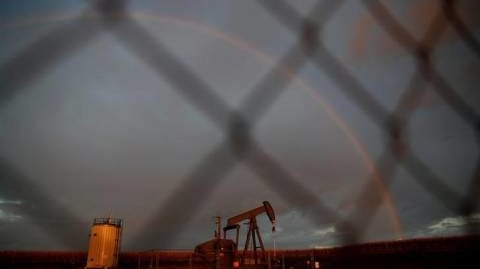
By Roslan Khasawneh and Aaron Sheldrick
SINGAPORE/TOKYO (Reuters) - Oil prices were steady on Friday as reports of sluggish economic growth in China, the world's biggest crude importer, raised concerns about fuel demand and countered optimism from the signing of the Sino-U.S. trade deal earlier in the week.
In the fourth quarter of 2019, the world's second-largest economy grew by an expected 6% from a year earlier, while the full-year expansion was 6.1%, the slowest in 29 years, government data showed on Friday.
"A well-expected fourth-quarter China GDP rate provided little clue for oil price trading on Friday morning, and mounting downward economic pressure will perhaps limit oil's upside in the mid- to long-term," Margaret Yang, market analyst at CMC Markets.
Brent crude futures inched down 4 cents to $64.58 by 0615 GMT, after gaining nearly 1% on Thursday. The contract was down 0.6% for the week, on track for a second weekly fall.
U.S. West Texas Intermediate futures slipped 7 cents at $58.45 a barrel, having risen more than 1% in the previous session. The contract was down about 1% for the week and also set for a second weekly decline.
Oil rose on Thursday after China and the United States signed their Phase 1 trade accord. The mood was further boosted after the U.S. Senate approved changes to the U.S.-Mexico-Canada Free Trade Agreement.
Surging Chinese demand in the form of refinery throughput figures offset the less positive economic growth data.
For 2019, Chinese refineries processed 651.98 million tonnes of crude oil, equal to a record 13.04 million barrels per day, and up 7.6% from 2018, government data showed. Throughput also set a monthly record for December.
The International Energy Agency offered a dim view of the oil market outlook for 2020 on Thursday. The agency forecast that oil supply would exceed demand for crude from the Organization of the Petroleum Exporting Countries (OPEC), even if members are fully compliant in their agreement with Russia and other producers to curb output, a grouping known as OPEC+.
"The next big factor I see on the horizon is whether OPEC+ would want to extend its cuts beyond Q1 2020, which at current price levels I think they might be incentivised to," said Howie Lee, economist at Singapore's OCBC bank.
The United Arab Emirates' energy minister said this week he expects a positive meeting when OPEC and its allies meet next in March.
OPEC+ has been capping its output since 2017 to balance supply and demand in the global oil market and prop up oil prices.
(Reporting by Roslan Khasawneh and Koustav Samanta in SINGAPORE and Aaron Sheldrick in TOKYO; Editing by Christian Schmollinger and Richard Pullin)